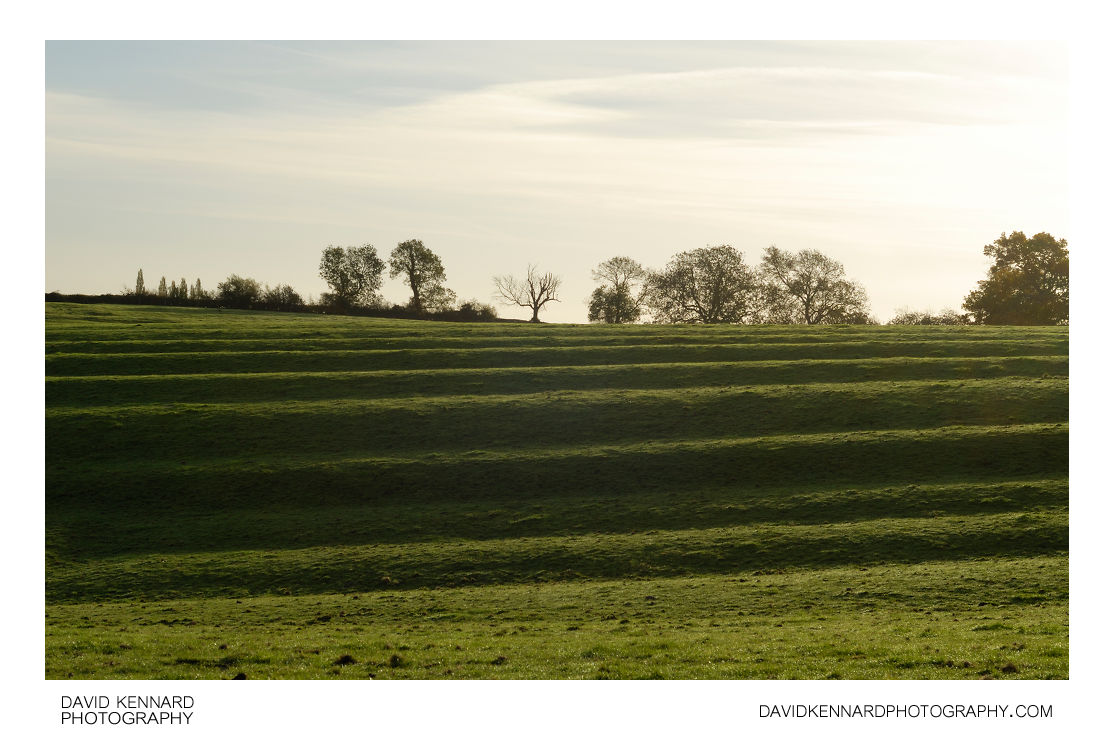Ridge and Furrow, East Farndon

Description
- Title:
- Ridge and Furrow, East Farndon
- Caption / Description:
-
The Ridge and Furrow farming pattern can be clearly seen on a hillside to the east of East Farndon, in Northamptonshire, England.
From Wikipedia (http://en.wikipedia.org/wiki/Ridge_and_furrow):
Ridge and furrow is an archaeological pattern of ridges and troughs created by a system of ploughing used in Europe during the Middle Ages. The earliest examples date to the immediate post-Roman period and the system was used until the 17th century in some areas. Ridge and furrow topography is found in Great Britain, Ireland and elsewhere in Europe. The surviving ridges are parallel, ranging from 3 to 22 yards (3 to 20 m) apart and up to 24 in (0.61 m) tall – they were much taller when in use. Older examples are often curved.
Ridge and furrow topography was a result of ploughing with non-reversible ploughs on the same strip of land each year. It is visible on land that was ploughed in the Middle Ages, but which has not been ploughed since then. No actively ploughed ridge and furrow survives.
- Tags / Keywords:
-
- Europe
- UK
- Britain
- England
- East Midlands
- Countryside
- Rural
- East Farndon
- Northamptonshire
- Medieval farming
- Ridge & furrow
Admin
- Date Original Photo Taken:
- Original File Name:
- _DSC2083-5.psd
- Event:
- Rating:
- ☆
- Date this image added/last updated on website:
- Original File Dimensions:
- 3858px x 2410px
- File Type:
- JPEG
- Color Mode:
- RGB
- Original Image Color Profile:
- Nikon Adobe RGB 4.0.0.3000
Location
- Location Shown:
-
- Sublocation:
- City:
- East Farndon
- Province/State:
- Northamptonshire
- Country:
- United Kingdom
- World Region:
- Europe
- Location Created:
-
- Sublocation:
- City:
- East Farndon
- Province/State:
- Northamptonshire
- Country:
- United Kingdom
- World Region:
- Europe
- Geo-location:
- 52.45742850475, -0.94284709972222 View on map
Rights
- Copyright Status:
- Copyrighted
- Licensing Status:
- Rights Managed
- Available for Editorial Use:
- Yes
- Available for Commercial Use:
- No
- Copyright Notice:
- © 2010 Dave Kennard
Camera Data
- Date Digital Resource was created:
- Shutter speed:
- 1⁄90 s
- Aperture:
- f/8
- Camera Model:
- Nikon D200
- ISO:
- 100
- Exposure Compensation:
- +1
- Focal Length:
- 50mm
- Focal Length (35mm equiv.):
- 75mm
- Metering Mode:
- Multi-segment
- Flash:
- No Flash
- Exposure Mode:
- Auto
- White Balance:
- Manual
- Light Source:
- Cloudy
- Exposure Program:
- Aperture-priority AE
Additional shooting metadata
- Lens:
- Nikon AF Nikkor 50mm F1.4D
- Filters used:
- Additional Optics used:
- Setup:
- Handheld, bracketed ±1EV
Post Processing
- Image Modified:
- Software used:
-
- Nikon Capture NX 2
- Adobe Photoshop CS5
- Post Processing:
NEFs converted with -0.3 exposure compensation in CNX2
EV-1 and EV0 images blended for focus in PS CS5
Curves adjustment to increase contrast in PS CS5
Top of image cropped off in PS CS5 to remove power lines
